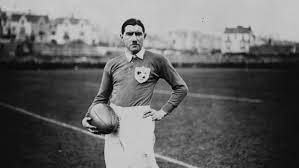Crawford helped redefine the role of full-back

OF all Methody's notable rugby alumni none have been more accomplished than Ernie Crawford, a maverick trailblazer with a Charlie Chaplin moustache and something of a forgotten name.
Crawford was a full-back of attacking inclinations who did much to redefine the role of a number 15 before Vivian Jenkins fully explored the attacking possibilities of the position.
A star of the Methody team in 1908 and 1909, Crawford's career was rudely interrupted by World War 1 and his Test career didn't start until 1920, aged 29 by which time most players had retired in that amateur era.
Despite that, Crawford went on to win 30 caps over the next eight seasons, a huge total at the time.
The England skipper Wavell Wakefield, a frequent opponent, described him as “a kind of brooding intelligence, directing the play, crouching and waiting like a spider for the unfortunate man who has to try to pass him”.
All this was achieved incidentally after losing the use of three fingers which were rendered paralysed when his wrist was badly damaged and the nerves severed during the Great War when serving as a second lieutenant in the 18th London Irish Regiment at the Battle of Arras.
After moving to Dublin following the War he not only captained the Lansdowne club but was also a prominent member of the Bohemians football club.
Crawford was one of six players from the team picked for Ireland's long squad for the 1924 Paris Olympics, although he was later one of the last to be cut.
Undeterred he was enlisted as a travelling reserve and caused something of a stir when customs officers found a firearm among his possessions when he entered the country. Asked to explain its presence Crawford declared that he needed it “for his peace of mind” and the French, always impressed and deferential towards returning war heroes, waved him through.
Later in life he was an extremely shrewd chairman of selectors after World War 2, an unprecedented era of success for the Irish culminating in the Grand Slam of 1948. He was also the president of the IRFU between 1957 and 1958.